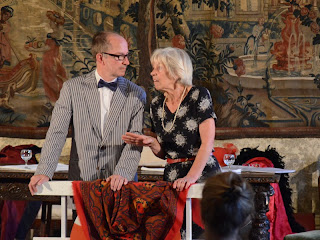 A survey of bats in the stables building was carried out in September 2009 and indicated that there is a number of bats roosting in the roof and numbers suggest that these are non-maternity roosts. Common and soprano pipistrelles, brown long-eared bats, and Natterers were all identified, although numbers were small.
A survey of bats in the stables building was carried out in September 2009 and indicated that there is a number of bats roosting in the roof and numbers suggest that these are non-maternity roosts. Common and soprano pipistrelles, brown long-eared bats, and Natterers were all identified, although numbers were small.It is hoped to commence bat walks during the summer months.
Pipistrelles are the commonest British bats, weighing around 5 grams (less than a £1 coin). A single pipistrelle can eat 3,000 tiny insects in just one night!
The common and soprano pipistrelle were only identified as separate species in the 1990s and look very similar. The easiest way to tell them apart is from the frequency of their echolocation calls (sounds produced by common pipistrelles are above the range of human hearing with the exception of social calls that may be heard by children and some adults with good hearing).
 Common pipistrelles feed in a wide range of habitats comprising woodland, hedgerows, grassland, farmland, suburban and also urban areas. They generally emerge from their roost around 20 minutes after sunset and fly 2-10m above ground level searching for their insect prey, which they catch and eat on the wing by ‘aerial hawking’.
Common pipistrelles feed in a wide range of habitats comprising woodland, hedgerows, grassland, farmland, suburban and also urban areas. They generally emerge from their roost around 20 minutes after sunset and fly 2-10m above ground level searching for their insect prey, which they catch and eat on the wing by ‘aerial hawking’.Soprano pipistrelles usually feed in wetland habitats, for example over lakes and rivers, and also around woodland edge, tree lines or hedgerows, and in suburban gardens and parks.
They generally emerge from their roost around 20 minutes after sunset and fly 2-10m above ground level searching for their insect prey, which they catch and eat on the wing by ‘aerial hawking’. Soprano pipistrelles appear to be more selective in their habitat use than the more generalist common pipistrelle and feed mainly on small flies, particularly midges and mosquitoes that are associated with water.
Populations of pipistrelles have declined dramatically in the last few decades. This is at least partly as a result of modern agricultural practices, although common pipistrelle populations have started showing signs of recovery in recent years. Their reliance on buildings for roosting makes them vulnerable to building renovations, exclusion and toxic remedial timber treatment chemicals.
 Brown long-eared bats are medium-sized. The ears are nearly as long as the body but not always obvious: when at rest they curl their ears back like rams’ horns, or tuck them away completely under their wings leaving only the pointed inner lobe of the ear (the tragus) visible.
Brown long-eared bats are medium-sized. The ears are nearly as long as the body but not always obvious: when at rest they curl their ears back like rams’ horns, or tuck them away completely under their wings leaving only the pointed inner lobe of the ear (the tragus) visible.As well as catching insects in free flight, brown long-eared bats are gleaners, often flying slowly amongst foliage, picking insects off leaves and bark. Their broad wings and tail allow slow, highly manoeuvrable, hovering flight .Sometimes they land on the ground to catch insects or to shift them into a controllable position in the mouth, and they are even able to take insects from lighted windows. Their flight often includes steep dives and short glides.
These bats are known as ‘whispering bats’ because their echolocation sounds are very quiet. They have particularly sensitive low frequency hearing and often locate prey from the sounds made by the insect’s own movements. They may sometimes use vision. Small prey is eaten in flight, but larger insects are taken to a ‘perch’.
Brown long-eared bats prefer to hibernate at very cold temperatures, often just above freezing point. Like the pipistrelles, it has declined in Britain due to changing land use, including modern intensive agricultural practices, and the conversion of barns which have resulted in the loss of suitable feeding and roosting habitats. It is particularly susceptible to pesticides, especially their use in roofs where it often roosts on exposed timbers.
Natterer's bat is a medium-sized European bat with pale wings. It has brown fur, also seen on the leg wing membrane, tending to white on its underside. It is found across most of the continent, but is considered scarce. It usually forages around trees and other vegetation, often gleaning insects from the surface of foliage. In the summer months it often roosts in old buildings with timber beams including buildings and barns. It mainly eats small flies, small moths, caddis flies, lacewings, beetles and spiders.














 Comment
Comment PIC: ANDREA JONES
PIC: ANDREA JONES PIC: ANDREA JONES
PIC: ANDREA JONES PIC: ANDREA JONES
PIC: ANDREA JONES PIC: ALAMY
PIC: ALAMY
















